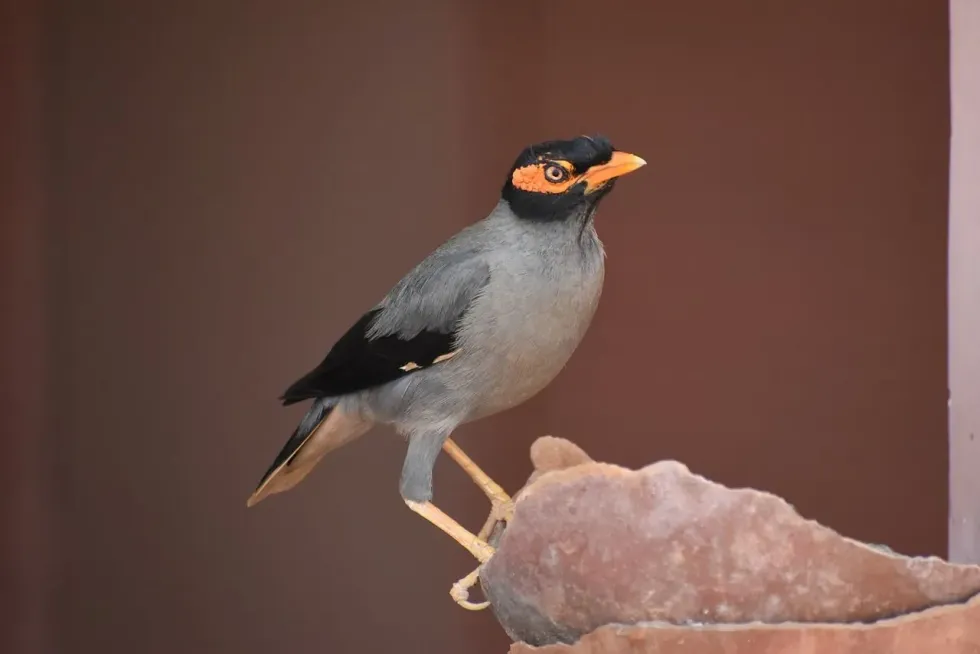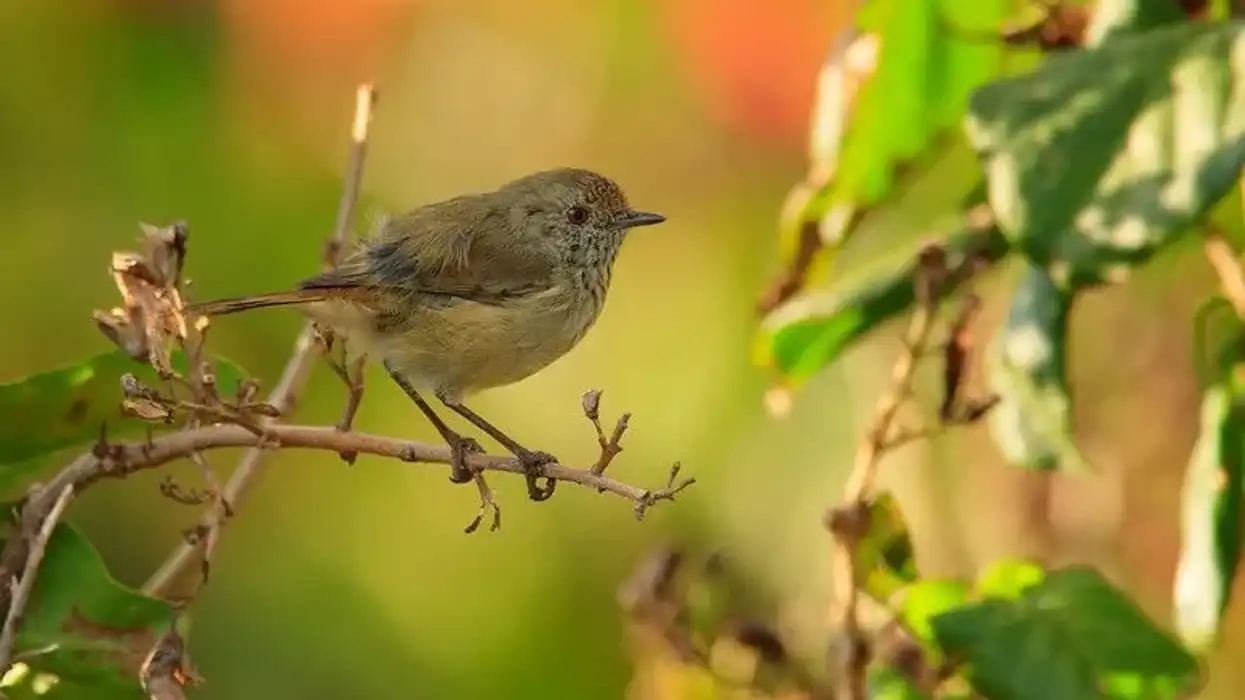The common myna (Acridotheres tristis) is a tropical bird that belongs to the starling family. It is also called the Indian myna. The species is among the native birds of southern Asia and is commonly found in countries like Afghanistan, Bangladesh, India, Pakistan, Sri Lanka, and Thailand.
It has also been introduced to other areas like Australia, South Africa, and the Pacific Islands to help control agricultural pests. But these birds adapt to their environment so well that some countries now consider them an invasive species.
They’re now one of the only three birds on the International Union for Conservation of Nature’s (IUCN’s) list of 100 most invasive species in the world.
Common mynas are well suited to urban areas and prefer to live in close proximity to humans. They eat a wide variety of fruits, vegetables, grains, insects, and even small creatures like mice and lizards. Common mynas mate for life and are usually seen in pairs.
This is why they are considered a symbol of love in some cultures. However, if its mate dies, a single myna will quickly find a new mate. Both male and female mynas feed chicks until they are ready to leave the nest.
For more relatable content, check out these summer tanager facts and palm warbler facts for kids.
Common Myna Interesting Facts
What type of animal is a common myna?
The common myna (Acridotheres tristis) is a species of bird.
What class of animal does a common myna belong to?
The common myna is a bird, so it belongs to the class Aves.
How many common mynas are there in the world?
There is not accurate estimate for their population worldwide.
Where does a common myna live?
With the exception of dense forests, common mynas can adapt to most kinds of terrain. All they need is a warm climate and freshwater access. They can live in open woods, the desert, farmland, or grasslands.
What is a common myna's habitat?
Common mynas like to live close to human settlements. These birds can be seen gathering and roosting in large numbers around cultivated fields, parks, and gardens, as well as urban structures like bridges and roadsides.
During the breeding season, they often begin nesting in the walls, ceilings, balconies, or windows of buildings. Nests can be quite messy and made with sticks, leaves, grass, and other debris they find lying around.
Who do common mynas live with?
Mynas are social birds. During the breeding season (March to September in their native range), mynas live in nests with their mates, guarding and providing food for their chicks. After the breeding season, they go back to roost in large groups which can include thousands of birds.
When foraging for food, adult mynas travel in small flocks of five or six individuals. Flocks can include pairs and families, as well as single birds.
How long does a common myna live?
The common myna bird has a life span of four years.
How do they reproduce?
Common mynas reproduce by laying eggs. During the breeding season, they lay up to six eggs at a time. They can lay up to three clutches in a single breeding season. Eggs are blue, or blue-green, and need to be incubated for 13-18 days.
Both males and females incubate the eggs and bring food for the chicks when they hatch. It takes 22-35 days for the chicks to be ready to leave the nest. About a week after leaving the nest, they are ready to fly independently.
What is their conservation status?
The common myna bird is quite common across most of the geographies it inhabits. Its population is increasing. Its conservation status is of Least Concern according to the IUCN Red List.
Common Myna Fun Facts
What do common mynas look like?

The common myna (scientific name: Acridotheres tristis) is a brown bird with a black head. Its beak, legs, and eye patch are contrasting bright yellow. The underside of its wings has white patches which only become visible when the bird takes flight. Male and female mynas look the same, but males can be a little bigger.
How cute are they?
With their striking yellow eye patch and beak, mynas look quite attractive. However, in temperament, they are quite aggressive and can even attack people on occasion.
How do they communicate?
Myna birds mainly communicate through vocal signals. They are extremely talkative and able to produce a wide variety of sounds, including whistles, gurgles, growls, and squeaks. They can copy the sounds produced by other birds and humans.
Common mynas communicate with each other through elaborate sequences of squawks, chirps, clicks and growls. During the breeding season, male mynas will fluff up their feathers, bob their heads, and call out to court females.
They use a wide variety of alarm calls to warn other birds about the presence of predators. Pairs of mynas will often sing while resting.
Parent birds use a particular call to communicate with the chicks in their nest. They are loud birds, and if there is a myna nest near you, you might find the constant chatter disturbing. A flock of mynas can be quite noisy. At dawn or dusk, they might vocalize together which can be very loud!
How big is a common myna?
The common myna is 9-10 in (23-26 cm) in length. It’s a bit smaller than the common hill myna, which is about 10.6-11.8 in (27-30 cm) in length.
This makes the common myna about half the size of a Mandarin duck.
How fast can a common myna fly?
The common myna bird has a top speed of 18.6mi/h (30km/h).
How much does a common myna weigh?
The common myna generally weighs between 2.8-5 oz (82-143 g).
What are the male and female names of the species?
Male and female myna birds don’t have unique names.
What would you call a baby common myna?
A baby common myna is called a chick.
What do they eat?
Myna birds are omnivores. The species is known for scavenging and eating almost anything. Their diet includes fruits and vegetables of many kinds.
They eat agricultural pests like locusts, along with other insects. They forage through kitchen waste to find scraps. They also eat eggs and chicks of other bird species, small reptiles like lizards, small mammals like mice, frogs, crabs, and other small creatures.
Are they aggressive?
Mynas are a fiercely competitive and highly opportunistic species. These birds can bully other bird species, driving them away from food sources. They’re aggressive in their nesting behavior. They damage other birds’ nests and feed on their eggs and young.
They also harm small mammal species, removing them from trees and using their homes as nesting locations. A pair of mynas will fight off other pairs to defend their chosen nesting sites. A myna will grab the intruder in its claws and jab it repeatedly with its beak.
These birds are seen as pests by humans in some geographies outside their native range. They damage crops, spread disease, steal food from people’s plates, and sometimes even attack humans. While a single myna can seem too small to cause significant damage, mynas can gang up on their competitors. This makes them quite an invasive and aggressive species.
Would they make a good pet?
Mynas have been sold as caged birds in many countries. They are quite vocal and can make entertaining companions. It’s better to get a pair of birds than a single bird. The cage should be large so they can fly between perches.
Did you know...
Mynas are some of the best mimics in the world. Like parrots, they can make a variety of sounds including whistles, growls, screams, and trills. Birds kept in captivity will learn how to talk like their humans!
Where do common mynas come from?
Common mynas are native birds in south Asia, including countries like Afghanistan, Turkmenistan, Kazakhstan, India, China, and Sri Lanka. In their native range, they are not considered an invasive species. In fact, they help farmers by eating insects that would otherwise damage crops.
In the 19th century, the common myna species was introduced to many other countries to help reduce the number of insect pests. But outside their native range, they have caused more harm than good.
They eat fruit from trees, damage crops, and destroy young plants in gardens. They feed in groups which can cause a lot of damage to orchards.
They’re also noisy and leave their droppings in or near areas of human habitation. Common mynas are considered a pest in many areas across South Africa, North America, Australia, New Zealand, the Pacific Islands, and the Middle East.
Getting rid of common mynas
Common mynas can be destructive to crops and other food sources, create noise, leave droppings, and spread disease and mites. For these reasons, in certain areas outside of their native range, people have tried various ways of reducing the myna population.
Small populations can be trapped in foraging traps and either euthanized or released in a different location. Poisoning is another method of control used in areas where there are no other species who can ingest the poison.
Other approaches can involve removing myna nests, modifying the habitat so that mynas no longer find it hospitable, and limiting resources available to the mynas.
Here at Kidadl, we have carefully created lots of interesting family-friendly animal facts for everyone to discover! Learn more about some other birds from our sulfur-crested cockatoo facts and common loon facts pages.
You can even occupy yourself at home by coloring in one of our Common Myna coloring pages.









